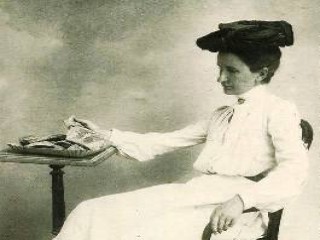
Harriet Boyd-Hawes biography
Date of birth : 1871-10-11
Date of death : 1945-03-31
Birthplace : Boston, Massachusetts
Nationality : American
Category : Arhitecture and Engineering
Last modified : 2011-06-06
Credited as : Archaeologist, ancient town of Gournia,
Harriet Hawes was the first female archaeologist to head an excavation. A classicist and scientist by training, she worked on the Greek island of Crete, discovering the ancient town of Gournia, one of Crete's "ninety cities" of Homer's Odyssey. Despite her international acclaim, Hawes devoted much of her free time to social activism, becoming involved with political issues of the day.
Harriet Ann Boyd Hawes was born in Boston on October 11, 1871, to Alexander and Harriet Fay (Wheeler) Boyd. The fifth child and the only girl, Hawes grew up in a family of men when her mother died suddenly during Hawes's infancy. She was close to her father, a leather-merchant, and to her brothers, especially Alexander, Jr., who shared her fascination with ancient history.
Hawes graduated from Prospect Hill School in 1888 before going on to Smith College. She graduated with a B.A. in 1892 and an M.A. in 1901. Between her years of schooling, Hawes taught classics—ancient and modern languages—in North Carolina and Delaware. From 1900 until 1906 she also taught modern Greek, epigraphy, and Greek archaeology at Smith.
In 1896, Hawes attended the American School of Classical Studies (ASCS) in Athens, Greece. As a woman, she was not permitted to take part in excavations sponsored by the ASCS. Hawes had been awarded the Agnes Hoppin fellowship in 1900, and she used the money to finance her own excavation. She wanted to follow up on recent archaeological work in Crete, and the fellowship allowed her to go.
Once in Crete, Hawes was advised by Arthur J. Evans, a British archaeologist excavating Knossos, to try the Kavousi region. In 1901, after securing funding from the American Exploration Society of Philadelphia, Hawes focused on the part of the region known as Gournia, in which she discovered an Early Bronze Age Minoan town site. The first woman to direct an excavation, she was also the first archaeologist to make such a discovery. Gournia was noted for its residents, artisans, and the part it played in the larger tapestry of Cretan society. The excavation, continued in 1903 and 1904, offered a significant amount of archaeological information to current studies. In fact, Hawes' discovery is still the only town from the Minoan age to be found in a well-preserved condition. In 1902, the Archaeological Institute of America sponsored her national lecture tour to describe her findings, which were later published in 1908.
Hawes met her husband, Charles Henry Hawes, a British anthropologist, in Crete, and they married on March 3, 1906. In December of that year, their son, Alexander, was born, followed by their daughter, Mary, in August of 1910. Hawes and her husband co-wrote a book on Crete during this time. After teaching appointments in Wisconsin and New Hampshire, Charles Hawes took a position as assistant director of the Boston Museum of Fine Arts in 1919. The following year, Hawes returned to teaching, this time at Wellesley College, where she lectured on pre-Christian art. She remained there until her retirement in 1936.
A lifelong activist, Hawes devoted much of her life to political and social causes. She was a volunteer war nurse in Thessaly (1897), Florida (1898), and Corfu (1916). In 1917 she organized the Smith College Relief Unit to aid French civilians. Later, in 1933, she gave aid to union shoe workers who were on strike, and was subsequently sued for $100,000 by the company.
Hawes and her husband retired to a farm in Alexandria, Virginia. After Charles' death in 1943, Hawes moved to a Washington, D.C. rest home, where she died of peritonitis on March 31, 1945. Smith College loved its archaeologist, awarding Hawes the honorary L.H.D. degree in 1910, creating a scholarship in her name in 1922, and holding a memorial symposium in Crete in 1967.



















